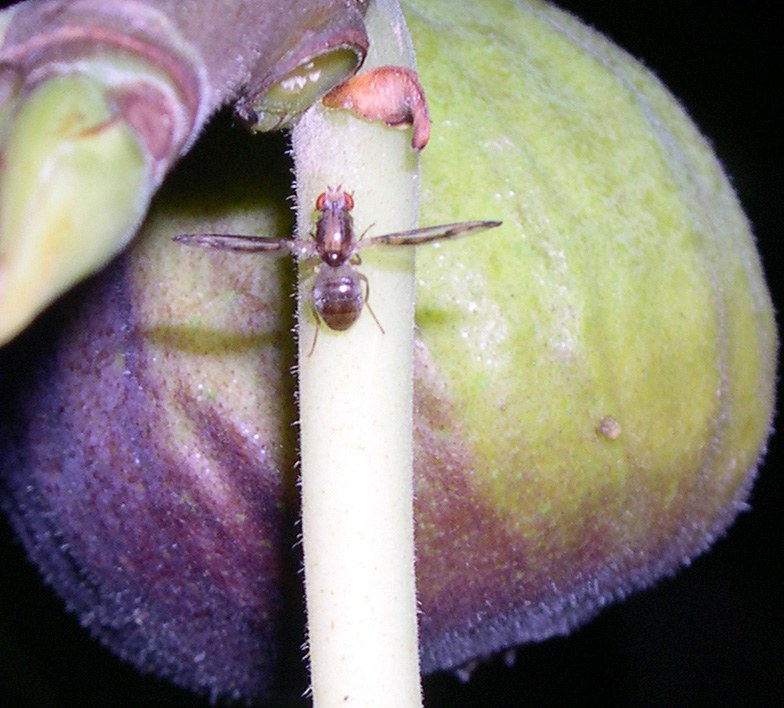Diptera.info :: Identification queries :: Diptera (adults)
Who is here? 1 guest(s)
|
Awesome fly Pallopteridae
|
|
| jorgemotalmeida |
Posted on 07-09-2006 21:03
|
|
Member Location: Viseu - PORTUGAL Posts: 9296 Joined: 05.06.06 |
Hi Today - 7th September 2006 - I found the most spectacular fly I've seen so far, here in Silgueiros - Viseu - PORTUGAL. It was found near the fruit of Ficus carica, about 7.30 pm. It had open wings all the time, in the position you will see in this photo. It had a beautiful design on the wings. I was in awe when saw this such beautiful fly. Unfortunately the photo is not so good.  But you can get an idea. But you can get an idea.  Is it Platystomatidae fly? IF so, which one? Thanks! edit: title... jorgemotalmeida attached the following image:  [188.48Kb] Edited by jorgemotalmeida on 07-09-2006 21:43 |
| Tony Irwin |
Posted on 07-09-2006 21:17
|
|
Member Location: Norwich, England Posts: 7279 Joined: 19.11.04 |
I think this is Palloptera muliebris (Pallopteridae)
Tony ---------- Tony Irwin |
|
|
|
| jorgemotalmeida |
Posted on 07-09-2006 21:24
|
|
Member Location: Viseu - PORTUGAL Posts: 9296 Joined: 05.06.06 |
Tony Irwin wrote: I think this is Palloptera muliebris (Pallopteridae) The design on wing is precisely like this Palloptera muliebris! wHY this cannot be a Platystomatidae fly? Is there any relation between Pallopteridae and Platystomatidae fly? All Platystomatidae flies move their wings when they are above a leaf? This fly doesn?t move the wings like Rivellia for example. |
| jorgemotalmeida |
Posted on 07-09-2006 21:52
|
|
Member Location: Viseu - PORTUGAL Posts: 9296 Joined: 05.06.06 |
Tony Irwin wrote: I think this is Palloptera muliebris (Pallopteridae) Just the pic is not convinced me about Palloptera. Isn?t it true that all pallopteridae has a very acute abdomen? not so round like this one... |
| Jan Willem |
Posted on 07-09-2006 21:53
|
|
Member Location: Waalwijk, The Netherlands Posts: 2150 Joined: 24.07.04 |
Hi Jorge and Tony, No doubt about it, this is Palloptera muliebris (or Toxoneura muliebris if you like). Why can't it be a platostomatid? Well, not visible in this picture, but this fly has a costal break which isn't present in Platystomatidae. This is just to name a simple character. There are several families with specimens moving their wings like that! Jan Willem |
|
|
|
| jorgemotalmeida |
Posted on 07-09-2006 22:02
|
|
Member Location: Viseu - PORTUGAL Posts: 9296 Joined: 05.06.06 |
Jan Willem wrote: Hi Jorge and Tony, No doubt about it, this is Palloptera muliebris (or Toxoneura muliebris if you like). Why can't it be a platostomatid? Well, not visible in this picture, but this fly has a costal break which isn't present in Platystomatidae. This is just to name a simple character. There are several families with specimens moving their wings like that! Jan Willem Is Toxoneura synonymia of Palloptera? Right?  yes. I saw a few moments ago that Pallopteridae flies are known as flutter flies.  But looking at the picture... there must be a way that you could say: "This is not a Platystomatidae fly because in this pic we can see ......" I want to know why it cannot be a Platystomatidae.. having the data presented on photo. Thanks!  |
| Tony Irwin |
Posted on 07-09-2006 23:15
|
|
Member Location: Norwich, England Posts: 7279 Joined: 19.11.04 |
The answer is that I recognised the wing pattern (even at the angle the wings are shown) as being Palloptera muliebris. If it had a dark wing with white spots, I would have much more difficulty saying what family it was.  But in Europe, we only have two genera of Platystomatidae - Platystoma and Rivellia, and neither of them look like this. (Look in the gallery for examples.) As Jan says, there are several familes that do the "wing-waving" - Trypetidae, Platysomatidae, Pallopteridae, Sepsidae, etc. so we need to consider all of them when looking at the photo. Edited by Tony Irwin on 07-09-2006 23:16 Tony ---------- Tony Irwin |
|
|
|
| jorgemotalmeida |
Posted on 07-09-2006 23:30
|
|
Member Location: Viseu - PORTUGAL Posts: 9296 Joined: 05.06.06 |
Tony Irwin wrote: The answer is that I recognised the wing pattern (even at the angle the wings are shown) as being Palloptera muliebris. If it had a dark wing with white spots, I would have much more difficulty saying what family it was.  But in Europe, we only have two genera of Platystomatidae - Platystoma and Rivellia, and neither of them look like this. (Look in the gallery for examples.) As Jan says, there are several familes that do the "wing-waving" - Trypetidae, Platysomatidae, Pallopteridae, Sepsidae, etc. so we need to consider all of them when looking at the photo. I know Rivellia very well.  I think some Sepsidae flies mimics ants! Isn?t it true? Anybody knows much more fly families (or some genus) that could mimics ants? I think some Sepsidae flies mimics ants! Isn?t it true? Anybody knows much more fly families (or some genus) that could mimics ants? |
| Jump to Forum: |













